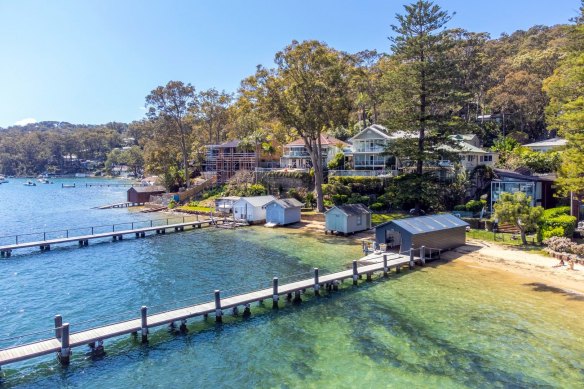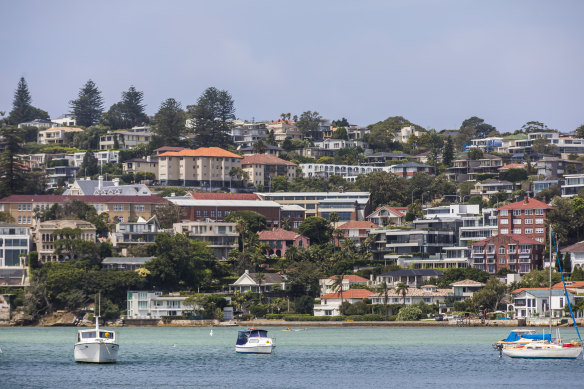This was published 1 year ago
Where are they now? Property prices drop in Sydney’s boomtime suburbs
By Kate Burke
Popular beachside suburbs where prices soared during the property boom have not been spared from the market’s steep downturn, new figures show.
But house values would need to fall far further to unwind the huge gains in some popular pockets during the market upswing, when record low interest rates and the flight to lifestyle locations pushed prices to new heights.

The median house value in Copacabana jumped 65.8 per cent during the market boom, and peaked in April this year.Credit: Stone Copacabana
House values in Central Coast suburbs such as Copacabana and Davistown jumped more than 60 per cent from March 2020, peaked in April this year, and have since fallen 13.6 per cent and 19.3 per cent, respectively, CoreLogic figures show.
Price growth in Newport, North Narrabeen and Avalon Beach was not far behind, up more than 50 per cent during the boom. House values in these suburbs have since fallen at least 20 per cent, but are still well up on pre-pandemic levels.
CoreLogic Australia’s head of research Eliza Owen said house values rose an average of almost 58 per cent in the top 20 growth suburbs during the boom, and were still 34 per cent higher than pre-pandemic levels on average, despite recent declines.
Large gains were generally followed by sharper declines, Owen said, but there were some areas that may have a lasting increase in values.
“The top end of the market has more volatility, but there are areas here that have boomed because they have a relatively affordable housing market which may have attracted more of a premium, or they have this lifestyle appeal where the value has been unlocked by the work from home trend,” she said.
Central Coast selling agent Andrew Thomson, principal of Stone Copacabana, said there was a clear shift in the market, even before the first cash rate hike in May.
“The sense of urgency disappeared. It was almost like you had 20 people at an open house and then the next week there was five, and you were checking … that you got the open house time right,” he said.
Copacabana had been long undervalued as the quiet cousin of Avoca Beach, before it was “discovered” during the pandemic, Thomson said.
Steep price growth was due to increased demand from sea changers and holiday home buyers. While that had eased, out-of-area buyers – particularly young families priced out of Sydney – still made up the bulk of interest, he said.
“It’s not uncommon when there is a quick rise that there is then a fairly proportionate correction,” he said. “[But] when [prices have] gone up 66 per cent and pulled back 10-15 per cent, you’re still up a lot over three years.”
House values in the suburb are still up 43.2 per cent since the start of the pandemic.
In Avalon Beach, house values are up 20.1 per cent on pre-pandemic levels, having fallen 22.1 per cent since January.

The median house value in Avalon Beach jumped 54.2 per cent between the start of the pandemic and January 2022. It has since fallen 22.1 per cent.Credit:
Veronica Allen of Belle Property Avalon said record low rates, closed international borders and remote working had increased demand for coastal homes. A shift in all three factors since had eased interest— particularly for weekenders and secondary homes.
“[Earlier this year] we were still holding some reasonably strong prices … but by the time we got to June, July, we saw a definite change.”
“[Prices have] continued to correct and adjust as we’ve closed the year,” she added, but noted unique properties had more subdued price declines of about 10 per cent.
Sydney-wide house values are 13.8 per cent higher than pre-pandemic levels, while unit values — which had a much smaller increase — are just 2.6 per cent higher, despite more moderate price falls.

Apartment values in Rose Bay have dropped 19 per cent since they peaked in November 2021. The median is still about 6 per cent higher than pre-pandemic levels.Credit: Anna Kucera
Owen said price gains during the COVID-19 boom, particularly for units, could be totally eroded in parts of Sydney.
Even top-growth unit markets like Mona Vale, Narrabeen, Rose Bay, Double Bay and Bellevue Hill — where values lifted more than 30 per cent — were 10 per cent or less above pre-pandemic levels. Mona Vale units were just 3.9 per cent higher.
Raine & Horne Double Bay principal Ric Serrao said there was still strong demand for apartments with good views or downsizer appeal, but investment properties were struggling.
“That market has come off between 10 to 20 per cent,” he said.
However, Serrao had seen an uptick in first home buyer interest recently, following the introduction of the property tax option which replaces upfront stamp duty costs with an annual payment. He had also seen more investor activity.
“If we aren’t at the bottom of the investment market, I don’t think we’re far off,” he said.